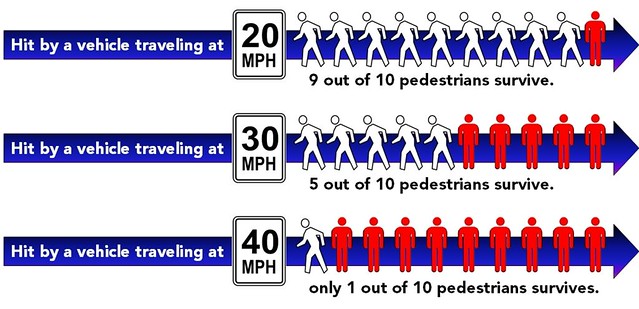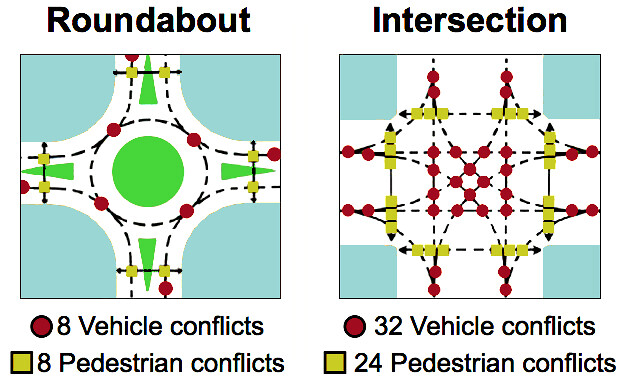From nextSTL:
http://www.youtube.com/watch?v=OvoFjirrgYA
Who doesn’t love MythBusters? I mean, I’m still perplexed by the staying drier by walking and not running in the rain thing, but these are generally pretty fun. So Jamie and Adam recently took on the traffic throughput of a four-way stop intersection versus a roundabout. You’ll have to check out the video above to the get the result, but one was 20% more efficient than the other. Of course for anyone intereseted in the four-way stop versus roundabout and how it actually works in a city, plenty of questions and issues were left undiscussed. This MythBusters was unfortunately only focused on the level of service for drivers.
How do the various intersections work for pedestrians? Bicycles? What about collisions in a roundabout? The traffic throughput may not even be the primary argument for roundabouts. Even if a roundabout handled the same or fewer cars, slowing traffic, and the elimination of dozens of points of conflict and the potential for head-on vehicle collisions would be a strong argument in their favor.
Recently we pulled together a compilation of videos showing how to navigate a roundabout and included images of the roundabout coming to University City: Nine Videos to Help You Navigate a Roundabout.
Added graphic to highlight the vital importance of slowing traffic at conflict points:

These discussions regarding roundabouts never seem to cease. Anecdotes can be helpful, but in this case, there is a large body of study on the issue. Unless one asserts some type of driver exceptionalism (see incompetence), the evidence that roundabouts safer than traditional signalized or signed intersections is overwhelming. The Institute of Transportation Engineers (ITE), Federal Highway Administration and many state DOTs agree. If you’re really into this, you can read the recent ITE here. A snapshot regarding previous research from around the world from that report:
In 1992, a before-and-after study was conducted in the Netherlands of 181 roundabouts that were previously stop controlled or signalized intersections. They found that the number of accidents in a year dropped by 51% on an average and the injury accidents decreased by an average forty four percent.
A before-and-after study of 73 roundabouts in Australia conducted in the year 1981 showed a reduction of 74 percent in the casualty (i.e., fatality) accident rate and a 32 percent reduction in property damage accidents.
In 1996, 34 modern roundabouts in Germany were studied. This study found that the number of fatalities and severe injuries decreased from 18 to 2. The number of accidents with heavy property damage decreased from 24 to 3.
France studied about 83 roundabouts in the year 1986, and concluded that the transformation of regular intersections into roundabouts yielded significant safety benefits. While the fatalities reduced by 88 percent, the injuries fell by approximately 78 percent. Another study of 522 roundabouts in the year 1988 found that 90 percent of them had no injury accidents at all.
In Switzerland, two roundabouts built in 1977 and 1980 were studied for 4-8 years after they were converted as roundabouts from the conventional intersections. The findings of the study were that there were reductions of 75 percent in total accidents and 90 percent in the number of injuries.




Did you know the two roundabouts on Cleveland Avenue in the residential areas of Annedsdale and Central Gardens have STOP SIGNS on two “sides”? In addition, there is no paint on the street reinforcing that’s it’s a roundabout (no arrow, circualr borders, etc). I’m pretty sure the city engineering dept just but in the center “hub” and some signs. My neighbors tell me the roundabouts are only about a decade old.
I happen to live at the corner of one of these disfunctional intersections. Because of it’s poor design, or should I say poor followthrough on the design, I have documented at least 6 wrecks at these reoundabouts, including one where the car actually flipped on it’s side. This in a residential neighborhood, where cars aren’t travelling at high speeds and where many many children walk to Bruce Elementary and Central High.
The City of Memphis and our Engineers should take these roundabouts all the way, losing the stop signs and adding other indicators, or dump them. I honestly worry that one day a car is going to end up in my living room, or worse a child will be killed. the problem isn’t that people in the osuth don’t understnad roundabouts, but that roundabouts shouldn’t have stop signs. It’ s anti-intuitive.
Absolutely. We need to go all in on roundabouts. They work beautifully all across Europe, but our engineers regularly tell us why they can’t work that way anywhere in Memphis and Shelby County. Incredible.
Of course, one issue that works against roundabouts is that traffic is never actually forced to come to a stop. The free flow nature of roundabouts and their associated right turn slip lanes can create an intersection where a yield condition is the safeguard for anyone seeking to cross the street. Thus a pedestrian crossing each lane must time their crossing with gaps that occur naturally in the flow of traffic and must assume that oncoming traffic will stop. Once can imagine that this could prove to be particularly tricky for anyone who might require a more lengthy crossing period such as those of advanced age and/or those who have a disability (blind, wheelchair, etc…).
The character of the roundabout must also be considered. For example, studies have shown that multi-lane roundabouts provide a reduced level of pedestrian safety when compared to a single lane design.
There is also the issue of bike safety. Bike lanes are not painted inside of roundabouts because research shows that bicyclists on the outside of traffic are more likely to be struck by motorists entering the roundabout who fail to see them. Thus, bicyclists are given 2 options: ride in the center of the lane of travel and maneuver according to vehicle regulations while in the roundabout or dismount and cross the circle as a pedestrian.
As for Cleveland, what was built are roundabouts in name only and were designed to simply slow traffic. They lack the entry medians that provide sheltered pedestrian islands in the street and simultaneously provide visual cues which inform drivers to veer right to continue around the “circle”. Another solution might be to eliminate the landscaped circle at the intersections and build curb “bumpouts” instead which will constrict the width of the roadway at intersections (and slow traffic) and minimizing the pedestrian crossing distance.
Sources:
http://sustainablecitiescollective.com/timothyboscarino/122461/roundabout-safety-mixed-results-pedestrians-cyclists
http://www.bicyclinginfo.org/
http://safety.fhwa.dot.gov/intersection/roundabouts/
In the last couple of years, we went to France and then to Ireland, and we admit that we have become starry-eyed about roundabouts. We absolutely loved them.